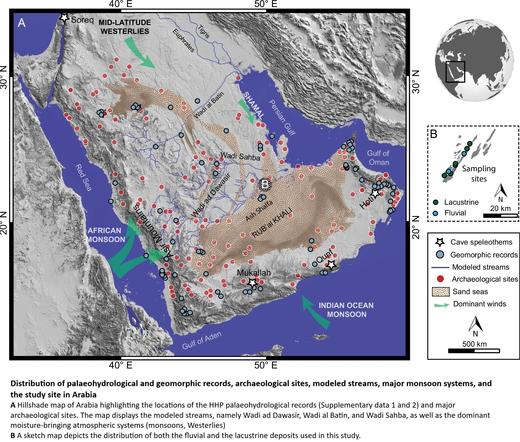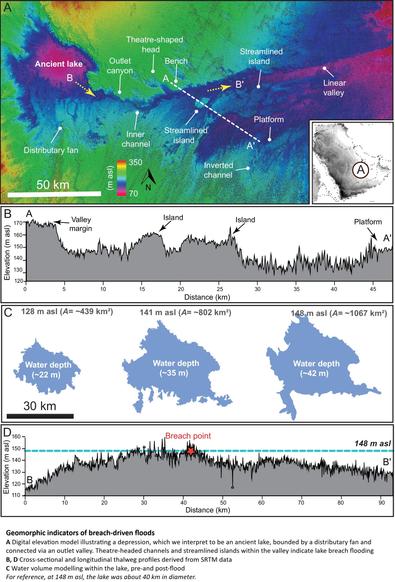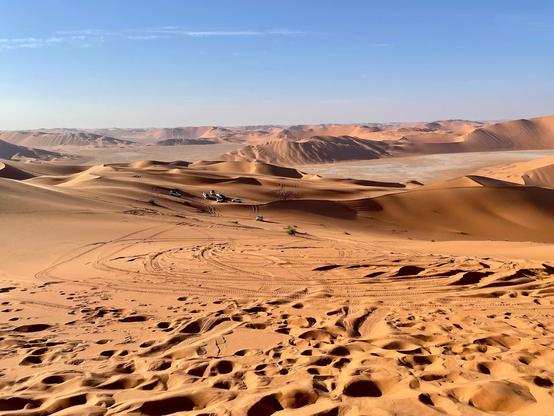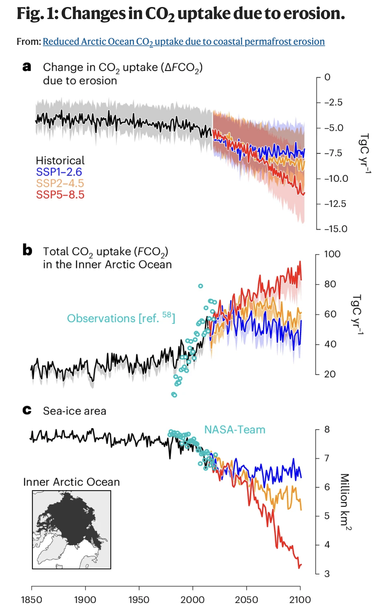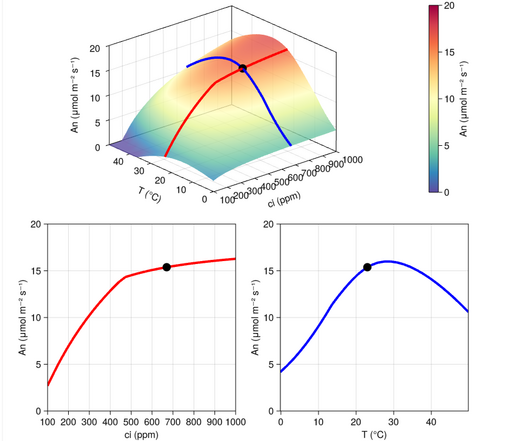Ancient Lakes And Rivers Unearthed In Arabia's Vast Desert
--
https://phys.org/news/2025-04-ancient-lakes-rivers-unearthed-arabia.html <-- shared technical article
--
https://doi.org/10.1038/s43247-025-02224-1 <-- shared paper
--
#GIS #spatial #mapping #water #hydrology #quaternary #desert #geomorphology #landforms #geomorphometry #Arabia #climatechange #RubalKhali #SaudiArabia #holocene #model #modeling #spatialanalysis #spatiotemporal #earthsystemmodel #geology #lacustrine #fluvial #sediments #sedimentary #flood #flooding #lakes #AfricanMonsoon #rivers #paleohydrology #stratigraphy #remotesensing #landsat #earthobservation #dating #delta #cliff #terrace #rainfall #precipitation
#earthsystemmodel
What if we could start a weather simulation and let it run over seasons, years, decades, centuries ...
This is at the heart of the ICON-Seamless Project developing a new #EarthSystemModel suitable for #weather and #climate forecasts.
This new ICON-XPP model is our working horse for the upcoming CMIP7 climate projections. It will also remain the horse we are working on 😉
At an all-hands workshop at the Seewetteramt #Hamburg last week we discussed progress and challenges.
@DeutscherWetterdienst
Please spread this #Job Opening in my group at Universität #Hamburg: Postdoctoral | #Research Associate in the Project “CAP7”.
The focus is to enhance the representation of ocean biogeochemical processes, carbon-climate feedbacks, and ocean carbon storage under changing emissions in the new generation #EarthSystemModel ICON-XPP.
These novel simulations will contribute to #CMIP7 and the next #IPCC assessment of #climatechange.
See how to apply 👇
https://www.uni-hamburg.de/stellenangebote/ausschreibung.html?jobID=2e0d47c3b6870aeb6c73a893985cc286d4d924d6
Acceleration of #climatechange is taking place due to our failure to cut increasing CO2 emissions.
Any impact of Arctic coastal #permafrost erosion on the global #climate through increasing atmospheric CO2 concentrations until 2100 is comparatively small.
Yet, this new #EarthSystemModel component allows for a better quantification of the carbon budget, necessary for carbon monitoring under #decarbonisation .
Read more in this press release 👇
https://www.uni-hamburg.de/en/newsroom/presse/2024/pm40.html
#ilyinaScience
In a #newpaper from my group, led by David Nielsen, we incorporated coastal permafrost as a new component of an #EarthSystemModel.
This allowed us to quantify that #coastal #permafrost erosion weakens the Arctic Ocean #CO2 uptake from the atmosphere by 7-14%.
This exerts a positive biogeochemical feedback on #climate, increasing atmospheric CO2 by 1–2 TgC yr−1 per °C of increase in global surface air temperature.
Find out more here👇
https://www.nature.com/articles/s41558-024-02074-3
#ilyinaScience
"Collaboration instead of academic competition" - my motto for the interview on the recent World Climate Research Program Workshop - "a climate modeling summit" - which we hosted in Hamburg. Find out why I believe so👇
https://www.cliccs.uni-hamburg.de/about-cliccs/news/2024-news/2024-05-03-esmo-meeting.html
What happens after a snowball Earth melts?
With the new #EarthSystemModel ICON, we find that the supergreenhouse climate was not necessarily a stable and hot climate over hundreds of thousands of years. It is also possible that the temperatures were moderate and even declined rapidly, on a time scale of just a few thousand years, in response to changes in the ocean C-cycle.
Find out in this news piece👇
https://mpimet.mpg.de/en/communication/news/was-passiert-wenn-eine-schneeball-erde-schmilzt
with more details in our new paper👇
https://doi.org/10.1038/s41467-024-47873-6
Once upon a time, only about 650 million years ago, our Earth was a snowball. What was the aftermath #greenhouse #climate triggering deglaciation and the ocean's role in it?
We addressed this intriguing scientific question via a set of #EarthSystemModel experiments in the new Nature Communication paper "Moderate greenhouse climate and rapid carbonate formation after Marinoan snowball Earth" led by Lennart Ramme within his PhD project.
Have a look at our simulation of the air-sea #CO2 flux and surface wind speed in a high-resolution #EarthSystemModel model ICON 👇
https://youtu.be/63NZSPjxv6w
I find September particularly fascinating in this animation. A hurricane in the Western Atlantic entirely messes up the CO2 flux. Here, the immediate effect is that the hurricane enhances the outgassing of CO2. Behind it, the flux swaps the sign and there is uptake of CO2.
CliMA is propelling accessibility to greater heights through user-oriented web applications. For example, we are currently prototyping platforms that will allow users to execute the land model across myriad FLUXNET sites. See our latest blog for the interactive tool. #julialang #earthsystemmodel https://clima.caltech.edu/2023/09/28/esm-as-a-puzzle-making-clima-accessible-piece-by-piece/
With my group, I study a #CDR method of artificially increasing ocean C-sink by adding alkalinity.
In an #EarthSystemModel
large amounts of alkalinity boost the oceans' capacity to absorb CO2.
This comes at a price of unprecedented perturbations in #biogeochemistry with unknown implications for marine life.
Learn more in our papers
https://doi.org/10.1002/2013GL057981
https://doi.org/10.1002/2016GL068576
https://doi.org/10.1029/2018GL077847
https://doi.org/10.1002/2017EF000620
https://doi.org/10.3389/fclim.2021.624075
https://doi.org/10.1029/2020EF001634
How does Earth breathe CO2 under different #ClimateChange scenarios?
Have a look at this visualization showing seasonal variations of atmospheric CO2 modulated by anthropogenic emissions and the strength of the ocean and land carbon sinks.
Computed with an #EarthSystemModel #MPI-ESM.
Details at #DKRZ Gallery:
https://www.dkrz.de/en/communication/galerie/Vis/esm/seasonal-variations-of-co2-under-climate-change
RT @nextgems_eu: What a marvelous simulation by our #ICON #EarthSystemModel with a resolution of 1-km! Get the full impression of the virtual #BlueMarble in the video below. 🌎🌍🌏
#DKRZ #WarmWorld @esiwace @nvidiaomniverse
🐦🔗: https://n.respublicae.eu/cinea_eu/status/1600813257279045632
Exciting news :thinkhappy: 📰
Our #manuscript presenting an application of coarse-grained component #concurrency for #ocean #biogeochemistry has been accepted for publication.
https://gmd.copernicus.org/preprints/gmd-2022-214/
Let me #decipher what this is 🤯
In an #EarthSystemModel, the #uptake and #storage of #CO2 in the #ocean is computed by the embedded ocean #biogeochemistry models. 1/
It is challenging to represent the #CoastalOcean #CarbonCycle in an #EarthSystemModel.
Due to a relatively coarse spatial resolution, #global models do not resolve the complex coastal #biogeochemical dynamics. #Regional models don't get the open-coastal ocean exchange at their boundaries.
Find out how we address this challenge with a telescoping #HighResolution #model:
https://mas.to/@TatianaIlyina/109444770151344342
Here is the link to the paper:
https://doi.org/10.1029/2021MS002789
